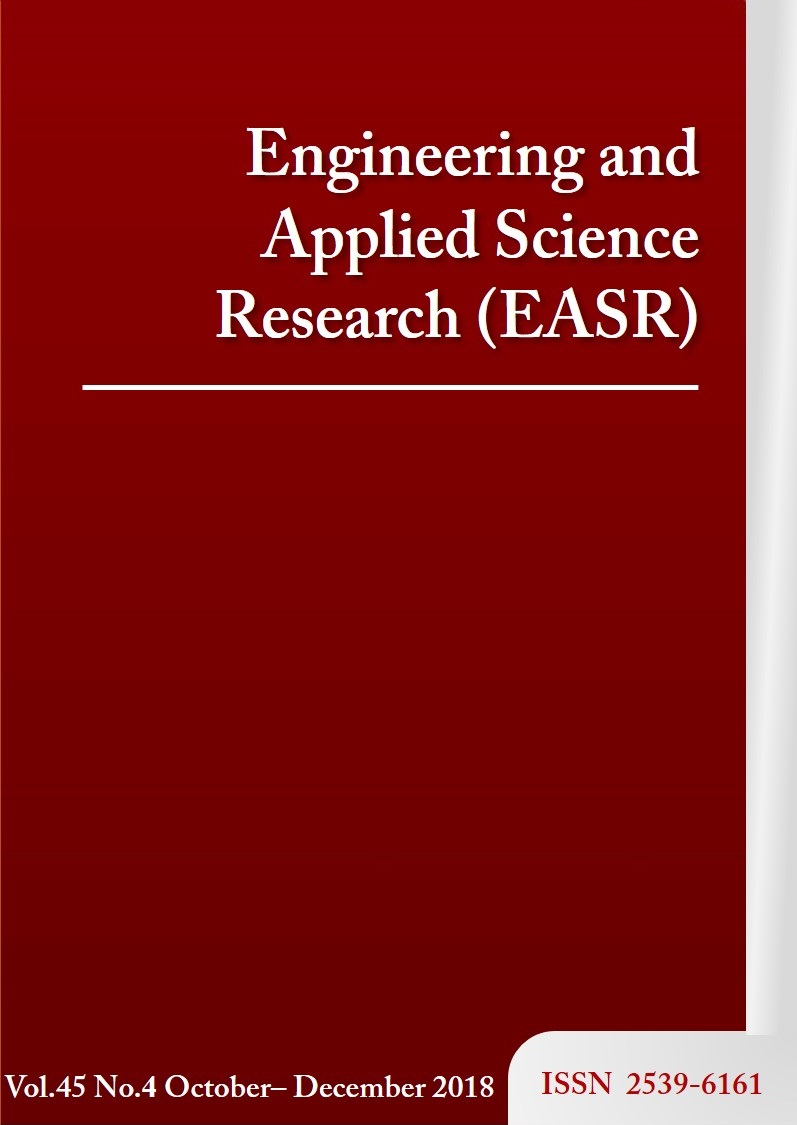Effect of aspect ratios on stress and strain of a multilayer model for the left ventricle
Main Article Content
Abstract
A basic understanding of the heart behavior assists in the accurate diagnosis of heart disease, which is the leading cause of death in Thailand. The mechanical behaviors of the heart can be ideally explained by strain and stress. This work numerically and analytically described three layers of the heart wall in a computational model, while previous studies only considered the myocardium, which is a muscular layer. Moreover, the shape of the left ventricle (LV) varies among individuals. The influence of the LV shape, as assumed to be a truncated ellipse, was considered by varying the short-to-long-axis and wall-to-cavity-volume ratios to investigate strain and stress in the radial, circumferential and longitudinal directions during a passive filling with blood using a continuum approach. For verification, the model was compared to other research work by defining the wall-to-cavity-volume and short-to-long-axis ratios as well by as fiber distribution. The results showed that an increasing short-to-long-axis ratio obviously resulted in decreased overall strains and stresses. Whereas, increasing the wall-to-cavity-volume ratio slightly decreased radial contraction as well as circumferential and longitudinal expansion. The fiber strains of the linear fiber distribution corresponded well with previous work at a high longitudinal curvature.
Article Details
This work is licensed under a Creative Commons Attribution-NonCommercial-NoDerivatives 4.0 International License.
References
World Health Organization. Noncommunicable diseases and mental health [Internet]. 2014 [cited 2017 August 8]. Available from: http://www.who.int/nmh/countries/tha_en.pdf.
Pantawet N, Chaiwan H. The issue of a campaign on world heart day 2015. [Internet]. Bureau of non communicable diseases [cited 2017 February 25]. Available from: http://www.thaincd.com/document/hot%20news/วันหัวใจโลก%202558.pdf.
Chadwick RS. Mechanics of the left ventricle. Biophys J. 1982;39(3):278-88.
Humphrey JD, Yin FCP. Constitutive relations and finite deformations of passive cardiac tissue II: Stress analysis in the left ventricle. Circ Res. 1989;65(3):805-17.
Sangpin P, Sakulchangsatjatai P, Terdtoon P, Kammuang-lue N. Pumping mechanics of the left ventricle based on thick-walled conical shell. Proceedings of the 3rd International Conference on Science, Technology, and Innovation for Sustainable Well-Being (STISWB III); 2011 Aug 12-15; Danang, Viet Nam; 2011. p. 235-41.
Khamdaeng T, Sakulchangsatjatai P, Kammuang-lue N, Danpinid A, Terdtoon P. Stresses and strains analysis in the left ventricular wall with finite deformations. Advanced Structured Materials 2011;14:33-42.
Choi HF, D’hooge J, Rademakers FE, Claus P. Influence of left-ventricular shape on passive filling properties and end-diastolic fiber stress and strain. J Biomech. 2010;43:1745-53.
Choi HF, Frank E, Rademakers E, Claus P. Left-ventricular shape determines intramyocardial mechanical heterogeneity. Am J Physiol Heart Circ Physiol. 2011;301:H2351-61.
Seeley RR, Stephens TD, Tate P. Anatomy & Physiology. McGraw-Hill. 8th ed. New York; 2008:678-720.
Humphrey JD, Strumpf RK, Yin FCP. Biaxial mechanical behavior of excised ventricular epicardium. Am J Physiol. 1990;259(1 Pt 2):H101-8.
Kang T, Humphrey JD, Yin FCP. Comparison of biaxial mechanical properties of excised endocardium and epicardium. Am J Physiol. 1996;270(6 Pt 2): H2169-76.
Okamoto RJ, Moulton MJ, Peterson SJ, Li D, Pasque MK, Guccione JM. Epicardial suction: A new approach to mechanical testing of the passive ventricular wall. J Biomech Eng. 2000;122(5):479-87.
Opie LH, Commerford PJ, Gersh BJ, Pfeffer MA. Controversies in ventricular remodeling. Lancet 2006;367(9507):356-67.
Ambale-Venkatesh B, Yoneyama K, Sharma RK, Ohyama Y, Wu CO, Burke GL, Shea S, Gomes AS, Young AA, Bluemke DA, Lima JAC. Left ventricular shape predicts different types of cardiovascular events in the general population. Heart 2016;103:481-2.
Adhyapak SM, Parachuri VR. Architecture of the left ventricle: Insights for optimal surgical ventricular restoration. Heart Fail Rev. 2010;15(1):73-83.
Budiman H, Talib J. Prolate spheroidal coordinate: An approximation to modeling of ellipsoidal drops in rotating disc contractor column. J Sci Technol. 2011;3(1):87-95.
Zhukov L, Barr AH. Heart-muscle fiber reconstruction from diffusion tensor MRI. Proc IEEE Visualization 2003;14:597-602.
Humphrey JD, Strumpf RK, Yin FCP. A constitutive theory biomembranes: Application to epicardial mechanics. J Biomech Eng. 1992;114(4):461-6.
Gou Z, Sluys LJ, Constitutive modeling of hyperelastic rubber-like materials. Heron J. 2008;53(3):109-32.
Sangpin P, Sakulchangsatjatai P, Kammuang-lue N, Terdtoon P. (in press). Stress and strain of multilayer model for the left ventricle. J Porous Media 2017;20.
Codreanu I, Robson MD, Golding SJ, Jung BS, Clarke K, Holloway CJ. Longitudinally and circumferential directed movements of the left ventricle studies by cardiovascular magnetic resonance phase contrast velocity mapping. J Cardiovasc Magn Reson. 2010;12:48.


